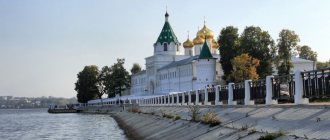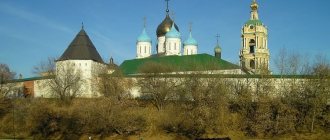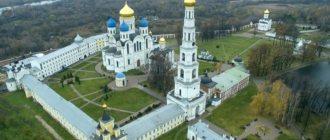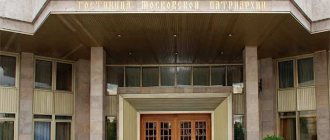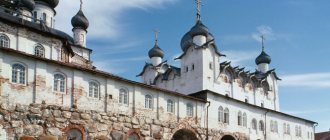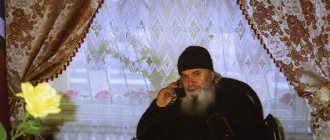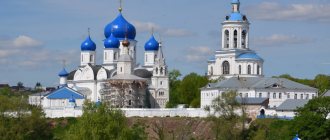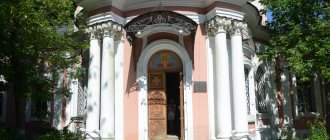Nowadays, pilgrimage is very common, since everyone, to one degree or another, wants to get acquainted with nearby religious buildings. And why not devote your free time to inspecting one of them, especially one that is quite popular. This time I decided to visit the Resurrection Belogorsky St. Nicholas Orthodox Missionary Monastery in the Voronezh region. It is famous for the temple of 1819, consecrated in honor of Alexander Nevsky, and attracts many with a particle of his relics. I’ll tell you about a wonderful holiday in Perm with peace and how to get to the Belogorsky Monastery .
Where is the Belogorsky Monastery located?
The Perm region is very rich in various religious shrines, among which one can note the quite famous Belogorsky Monastery, the distance to which from Voronezh is 165 km, from Belgorod - 314 km and from Volgograd - 517 km.
Address of the Belogorsky Monastery: Perm region, Voronezh region, Podgorensky district, Belogorye village, Kirpichi village, Alexander Nevsky street, 1.
- Telephone number of the Belogorsky Monastery: +7 (47394) 52-3-21,
- cell phone
What is the best way to get to the Belgorod Monastery
In order to get to the Belgorod Monastery, you can use several types of transport that are suitable for travelers with different financial status. How to get there by car
- Getting there from Voronezh, you should follow the M4 highway, which will lead to a sign for Rossosh, Belogorye, Babka, about 15 km before reaching Pavlovsk. After this turn, you still need to drive about 7 km to Belogorye. Having contacted the abbots of the Trinity Church in the village of Belogorye, follow their instructions on which route is best to get to the monastery. Depending on the chosen route, you will need to travel another 3 to 10 km to reach the Kirpichi village.
- When getting along the Voronezh - Lugansk highway from Ostrogozhsk, you need to get to the village of Podgorensky. At the end of the village, not far from the cement plant, you should turn towards Pavlovsk, before reaching which about 30 km there will be the village of Belogorye, where in the Trinity Church they will tell you the further way to the monastery.
How to get there by train Any electric train or passenger train that stops at Podgornoye station. Then you should take a minibus to Pavlovsk, on the way to which you will need to get off in the village of Belogorye. How to get there by bus Almost any bus goes to the village of Belogorye in the direction of Pavlovsk, Rossosh, Olkhovatka or Podgorny. For example, you can get from Voronezh by bus to Rossosh at 8:00, 14:55 and 16:30, to Podgorensky at 11:20 and 15:20. From Belogorye to the village of Kirpichi it is about 3 km, which you can either walk or ask one of the locals to take you. How to get there by boat A passenger boat offers its services to pilgrimage groups of up to 50 people, delivering travelers to the monastery, on the way to which the beauty of the Don River awaits them. In this case, you need to book your tickets in advance, which can be ordered by calling:
- 8 (47362) 7-13-63,
- 8 (47362) 2-54-47,
- 8 (47362) 2-53-47
- or cell phone: 8-903-030-68-12.
History[edit]
Photo dated January 1, 1904.
In 1891, in memory of the “miraculous deliverance of Tsarevich Nicholas from danger in Japan,” a seven-foot cross, popularly nicknamed the Tsar’s cross (height 10 m 65 cm), was erected on White Mountain.
The site for the foundation of the temple on White Mountain was consecrated on June 18, 1893. Construction of the first wooden church was completed in February 1894. Also in 1894, construction began on the rector's and fraternal buildings, which later housed a carpentry and metalworking workshop. A school was opened to educate orphan boys; until 1917, 25 orphans were educated on White Mountain. At the monastery school, children were taught literacy, church singing, and various crafts.
On September 16, 1897, the first procession of the cross arrived on the White Mountain; five holy icons were delivered from Moscow and St. Petersburg to the White Mountain:
likeness of the Kazan Icon of the Mother of God
image of St. Sergius of Radonezh
image of the Kazan Mother of God, painted by monks of the Valaam Monastery
image of the holy noble prince Alexander Nevsky
image of the Mother of God “Novices”
But three years after construction, on November 16, 1897, the wooden temple completely burned down. In the same 1897, construction of a stone two-story building for the older brethren began.
The laying of the new stone church (Cathedral of the Exaltation of the Cross) took place on June 24, 1902. The construction of the temple lasted 15 years; at the end of construction, the temple could accommodate 8 thousand people. The chief engineer of the project was E.I. Artyomov, the building material was supplied by the monastery brick factory. The temple was completed and opened in 1917, the consecration of the temple lasted from June 7-9, about 30 thousand people attended the consecration ceremony.
During an audience with Emperor Nicholas II on December 8, 1910, Belogorsk Archimandrite Varlaam gave him a book about the history of the monastery and photographs of the monastery. In 1912, the Belogorsky Monastery published the magazine “Voice of Duty” with an Orthodox-patriotic orientation.
During the First World War, the Belogorsk Monastery donated (03/19/1916) 500 rubles in gold coins to the needs of the Russian army.
Holy Cross Cathedral
Cathedral of the Exaltation of the Cross before the revolution
The Exaltation of the Cross Cathedral was built in the neo-Byzantine style, modeled on the Vladimir Cathedral in Kyiv. From the very beginning, the temple was equipped with ventilation and steam heating.
The monumental cathedral, the most grandiose in the Perm diocese, was built both with donations from private individuals and at the expense of the monastery itself; according to the monastery’s reports for 1909, the monastery was engaged in arable farming, cattle breeding, beekeeping and fishing, the monastery owned 580 acres of land, had 40 cows and 9 ponds.
Soviet time
Tragic events struck the monastery already in 1918. On August 25, 1918, the Bolsheviks tortured and threw Archimandrite Varlaam into the Kama River. From August 1918 to January 1919, the Bolsheviks shot and tortured 34 monks of the Belogorsk Monastery.
On February 24, 1919, the white troops of General Verzhbitsky, having made a forced march from Kungur, liberated White Mountain from the Bolsheviks. By this time, the Bolsheviks had destroyed and plundered the monastery. A few months later, on July 1, 1919, the Bolsheviks captured Perm, and soon the entire Perm region; four years later, in March 1923, the monastery was finally closed.
Since 1930, a camp for repressed and special settlers was opened on Belaya Gora, and a home for the disabled was opened a year later. In 1941-1945, a rehabilitation center for wounded and disabled people of the Great Patriotic War was located on Belaya Gora. From 1946 to 1986, on White Mountain there was a home for disabled people of the Great Patriotic War, labor and childhood. In 1980, a fire broke out in the Belogorsk Cathedral, which severely damaged the temple; in particular, almost all the domes of the temple burned down.
Visiting hours and opening hours
The monastery has its own visiting regime, in which men are not allowed to wear shorts, women are not allowed to wear miniskirts or trousers, and must be sure to cover their heads. No beachwear, revealing clothes or sportswear are allowed. It is also not allowed on the territory of the monastery:
- smoking;
- drinking alcohol;
- foul language;
- running and noise.
The Belogorsky Monastery receives pilgrims from April to October every day and around the clock. From October to April it is closed, and all services are held in the courtyard of the Trinity Church in Belogorye.
A special place
Belogorsky Nikolaevsky Monastery is located on Mount Belaya. This area received this name because it does not shed snow cover for a long time.
In the 18th century this place was a refuge for Old Believers. At the official level, the history of Orthodoxy here dates back to the end of the 19th century. Here Tsarevich Nicholas managed to escape. In honor of the significant event, a cross of impressive size was erected. Its height exceeded 10 meters. The people called the cross “Royal”.
Schedule of services at the Belogorsk Monastery
From Monday to Friday 06:00 – A prayer service and morning prayers are held, then the Midnight Office, Matins and the Liturgy. 18:00 – Ordinary Vespers and Little Compline with the canon to the Most Holy Theotokos, and evening prayers are also said. Saturday 07:30 – Time for morning prayers, midnight office, liturgy and memorial service. 18:00 – The usual all-night vigil takes place. On Sundays and holidays 07:30 – Time for morning prayers, midnight office, liturgy and a prayer service is said.
Where can you stay nearby?
- You can stay overnight at the Belogorsk Monastery itself. A small hotel is provided for pilgrims , although it has very modest amenities.
- For those whose financial situation allows them to stay in a room with good amenities, the nearest hotel is in Voronezh, which is a 2-hour drive from the monastery by car or 2.5-3 hours by bus.
The approximate cost of a double room in one of the hotels in Voronezh is from 1,400 rubles per night.
The history of the creation of the Belogorsk Monastery
The idea of creating the Belogorsk monastery appeared around 1796 , when Maria Sherstyukova, the daughter of the Ukrainian Cossack Konstantin Bosogo, decided, with the blessing, to found a community that began digging caves in the slopes of the mountain and eventually took on the role of abbess of the monastery. During her lifetime, approximately 212 meters of caves were dug. Both the abbess’s associates and she herself took part in the digging. By the beginning of the 20th century, the total length of the caves was 2 km. At the same time, religious buildings of the monastery were erected. In 1875, the Belogorsk monastery, even before the appearance of the monastery, had its own abbot - Hieromonk Peter, who was distinguished by his energy, severity and at the same time kindness. Church of the Resurrection was founded . His petitions to create a monastery were approved, and already in 1882 the Synod approved the monastery. There were a lot of donations of both land and material resources.
Current state[edit]
The beginning of the revival of the monastery is considered to be 1988-1989, when the 1000th anniversary of the Baptism of Rus' was celebrated. On January 29, 1991, the Holy Synod granted the request of Archbishop Athanasius of Perm and Solikamsk for a blessing to open the St. Nicholas Monastery on White Mountain, where monastic life was resumed.
On May 26, 1991, the first divine service in the reviving monastery was held in the upper church of the Cathedral of the Exaltation of the Cross.
With the arrival of His Eminence Methodius, Metropolitan of Perm and Solikamsk, to the Perm See in 2010, the pace of restoration of the Cathedral of the Exaltation of the Cross of the Belogorsk Monastery accelerated. Control over the progress of restoration work was transferred to the diocesan construction department, which was created in the Perm diocese by Bishop Methodius.
In 2011, the website of the Belogorsk Monastery “Ural Athos” (https://www.uralafon.perm.ru) was created, and the monthly newspaper “Voice of Duty” began to be published. The monastery is often visited by pilgrims.
Architectural and cultural landmarks
On the territory of the Belogorsk Monastery there are three main architectural attractions.
- The Ascension Church is one of the above-ground churches of the monastery. It was consecrated in honor of the Ascension of the Lord and operated for a long time. It was demolished after the revolution. Now being restored.
- The Resurrection Cathedral is the second above-ground church and the largest church of the monastery, consecrated in honor of the Resurrection of Christ. Byzantine style architecture. However, in 1931 it was blown up. Currently under restoration.
- Alexander Nevsky Church is a cave temple, consecrated by Archpriest Pechersky in honor of Prince Nevsky. At the beginning of the 21st century, it became the first revived single-limit church of the restored monastery.
Pre-revolutionary period
But they did not rejoice at the new building for long. The revolutionaries noticed the building and began to persecute the clergy. Archimandrite Varlaam and many of the monks were cruelly tortured.
5 years passed, and the monastery was closed completely. The building was used as a place for torture of dispossessed and repressed citizens. Later, a home for the disabled was organized here.
At the end of the 20th century, the temple burned again; the domes of the cathedral were destroyed by fire. The restoration of the temple began during the reign of Gorbachev.
Photo of Belogorsky Monastery, Perm Territory
Belogorsk Cave Church before the bishop's service.
One of the entrances to the caves of the Belogorsk Monastery.
Belogorsky Monastery in winter.
Stairs in one of the caves of the Belogorsk monastery.
